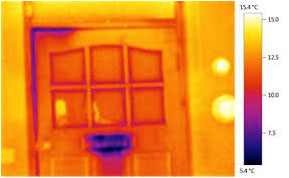January 2021
GO GREEN WIDCOMBE has superseded Energy Efficient Widcombe – Please visit Go Green Widcombe instead
Background
Energy Efficient Widcombe is a volunteer group within the Widcombe Association and works with other local volunteer and professional groups. EEW is also supported by Transition Bath, Age Concern, Bath and B&NES Council .
EEW aims to involve and assist as many Widcombe residents as possible to:
- reduce energy consumption and energy costs
- reduce carbon emissions, and
- identify those in fuel poverty.
Why?
- Climate change needs action
- Fossil fuel supplies are finite – and their cost will spiral affecting all of us
- Widcombe mainly has homes that are hard to make energy efficient
- in B&NES 41% of carbon emissions is from our homes.
What do we do?
EEW has carried out various activities. Mainly we have:
- visited homes to carry out energy surveys using a thermal imaging camera
- carried out more in depth surveys of community buildings and businesses
- taught children in Widcombe schools about energy saving measures.
Can we help you?
If you are concerned about energy efficiency in your home, you can contact us via the email link below. We have a thermal imaging camera which we can use to assess the places in your home where heat losses are occurring.
Contacts: Tim Williamson
Email: e.e.widcombe@gmail.com

Useful Information on Common Heat Loss Problems
From the surveys we have done, we have identified the common places where energy efficient measures would help. Please scroll down below for specific information on each area.
Energy efficient lighting
External doors
Letter box
Wall insulation
Windows
Attic insulation
Attic hatches and ceilings
Ground floors
Radiators on external walls
Condensation
Open chimneys
Energy efficient lighting
There are now more options than ever to save energy and money on lighting. A single GU10 halogen downlight (spotlight with two thick studs) consumes 50W of electricity. An equivalent LED consumes 5W, a saving of 45W.
The average UK home has 15 halogen lights. So if these lights are left on for 2 hours each day, at 16p per kWh, that’s a saving of £79 per year. And about 250kg of CO2 emissions would also be saved. The cost of the LED GU10 replacements varies between about £1 and £10, so the return on investment is therefore between 2 and 23 months.
Transition Bath has created a Try Before You Buy LED kit, which allows you to see and test the different types of LEDs available. These come in different light tones, different beam angles and can also be used with dimmer switches. This box is available from Bath Central Library, or contact us at EEW and we can arrange for you to borrow it.
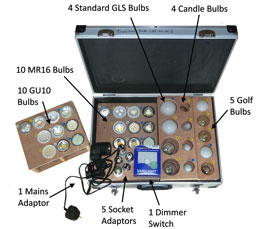 LEDs are available to buy from a wide range of outlets but prices vary significantly. Some online retailers to look at are https://www.ledhut.co.uk/ and www.lightrabbit.co.uk. If you prefer not to buy online, Screwfix has a good and reasonably priced range. For more information about replacing halogens with LEDs, Transition Bath has produced a short guide which you can read here: http://transitionbath.org/ledlighting/
LEDs are available to buy from a wide range of outlets but prices vary significantly. Some online retailers to look at are https://www.ledhut.co.uk/ and www.lightrabbit.co.uk. If you prefer not to buy online, Screwfix has a good and reasonably priced range. For more information about replacing halogens with LEDs, Transition Bath has produced a short guide which you can read here: http://transitionbath.org/ledlighting/
External doors
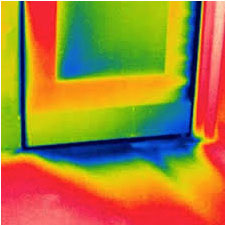 Where there is cold air coming in around externaldoors we recommend improving the draught proofing around the door by upgrading draught strips where these are in place and adding them if absent. There are lots of different draught-proofing methods easily available in DIY stores.
Where there is cold air coming in around externaldoors we recommend improving the draught proofing around the door by upgrading draught strips where these are in place and adding them if absent. There are lots of different draught-proofing methods easily available in DIY stores.
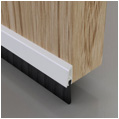
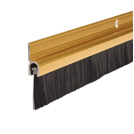 For the bottom of the door, there are two specific fittings: a concealed fixed bottom door fitting or a brush fitting.
For the bottom of the door, there are two specific fittings: a concealed fixed bottom door fitting or a brush fitting.
A “sausage dog” is a quick and easy solution.
If space allows, consider using a curtain to cover the inside of the doors in colder months.
The introduction of a porch – if it’s possible – will provide excellent protection against draughts.
Wall insulation
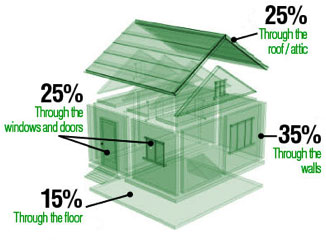 Those in houses built since the 1930s are likely to have cavity walls – so cavity wall insulation is recommended. About 35% of heat loss occurs through the walls.
Those in houses built since the 1930s are likely to have cavity walls – so cavity wall insulation is recommended. About 35% of heat loss occurs through the walls.
If you have an older house with single Ashlar solid stone walls, these colder walls commonly attract condensation. External and internal wall insulation are possibilities. For more information:
http://www.energysavingtrust.org.uk/home-insulation/solid-wall
And contact “Energy at Home” on Freephone 0800 038 5680 for info about free assessments and grants.
Windows
 There may be draughts around window frames – these can be addressed by using draught proofing strips around the frame. Even if they’re not draughty, large windows can feel cold. Simply closing curtains or blinds at dusk can reduce heat loss by around 15%.
There may be draughts around window frames – these can be addressed by using draught proofing strips around the frame. Even if they’re not draughty, large windows can feel cold. Simply closing curtains or blinds at dusk can reduce heat loss by around 15%.
Most houses benefit from double glazing, but some older installations are becoming less energy efficient. If you have single glazed windows letting in a lot of cold air or if there is excessive condensation, you could consider installing secondary glazing or replace single glazing with double glazed units. The council provides some useful information about energy efficiency upgrades for listed buildings with an explanation of the potential savings, and also what permissions are required:
If you have older sash windows that are difficult to draught-proof, replacing the windows or re-conditioning them will pay off. The results can be impressive. There are two local companies that do this.
Attic insulation
 Where thermal images of the ceiling suggest that the insulation may be patchy, we would recommend reviewing this and either adding to what is there or replacing it. The recommended depth for the blanket style insulation is 250-270mm.
Where thermal images of the ceiling suggest that the insulation may be patchy, we would recommend reviewing this and either adding to what is there or replacing it. The recommended depth for the blanket style insulation is 250-270mm.
We do not have a view on which type of insulation to use. The most common types of materials used for loose-fill insulation include cellulose, fiberglass, and mineral (rock or slag) wool. All of these materials can be produced using recycled waste materials. Cellulose is primarily made from recycled newsprint. Most fiberglass products contain 40% to 60% recycled glass. This is a relatively cheap measure with massive benefits.
Attic hatches
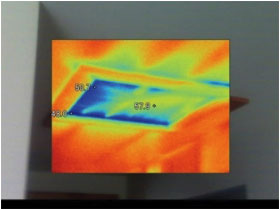 If the loft hatch has not been insulated, it is an easy job to fit a square of board insulation to the inside of the hatch. This boarding is easily available from hardware / DIY shops – and is easily cut to size. Also consider adding draught proofing strips around the edge of the hatch.
If the loft hatch has not been insulated, it is an easy job to fit a square of board insulation to the inside of the hatch. This boarding is easily available from hardware / DIY shops – and is easily cut to size. Also consider adding draught proofing strips around the edge of the hatch.
Ground floors
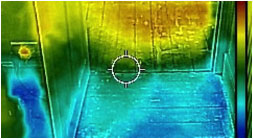 If you have a cellar, basement or undercroft running underneath your house, it is worth considering insulating under the floorboards to stop cold air seeping into the rooms above. The Energy Saving Trust has a comprehensive guide to different types of insulation:
If you have a cellar, basement or undercroft running underneath your house, it is worth considering insulating under the floorboards to stop cold air seeping into the rooms above. The Energy Saving Trust has a comprehensive guide to different types of insulation:
http://www.energysavingtrust.org.uk/home-insulation
Some insulation work may be eligible for a grant from the local authority. B&NES Council provides some advice on this here:
https://www.energyathome.org.uk/
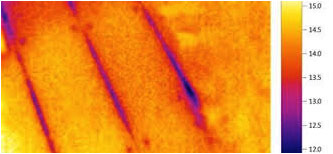 Here are areas of floor showing cold air coming through the floor boards from below. It would be worth sealing the gaps with draught excluding material such as the V shaped excluder. DraughtEx is a good solution, and specific for the job:
Here are areas of floor showing cold air coming through the floor boards from below. It would be worth sealing the gaps with draught excluding material such as the V shaped excluder. DraughtEx is a good solution, and specific for the job:
https://www.draughtex.co.uk/?fga=true&gclid=EAIaIQobChMIqr7vhLWi3wIV1uJ3Ch2CgA6hEAAYASAAEgK_L_D_BwE
Radiators on external walls
 Traditionally radiators were fitted on external walls, typically under windows. Heat loss through the external wall is plain to see. It can be reduced simply by using a reflective foil behind your radiator. This will reflect the heat back into the room rather than it being lost through the wall. Reflectors are easily installed behind the radiator with no need to take the radiator off the wall. They can be bought cheaply on most DIY stores.
Traditionally radiators were fitted on external walls, typically under windows. Heat loss through the external wall is plain to see. It can be reduced simply by using a reflective foil behind your radiator. This will reflect the heat back into the room rather than it being lost through the wall. Reflectors are easily installed behind the radiator with no need to take the radiator off the wall. They can be bought cheaply on most DIY stores.
There is some useful information here:
Condensation
 A number of houses we visited were experiencing problems with condensation. The Energy Saving Trust has a useful troubleshooting guide on its website to help you reduce or eliminate condensation:
A number of houses we visited were experiencing problems with condensation. The Energy Saving Trust has a useful troubleshooting guide on its website to help you reduce or eliminate condensation:
http://www.energysavingtrust.org.uk/home-insulation/damp-and-condensation-solutions
Unused open fireplaces
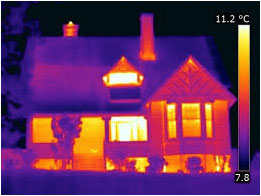 Your chimney works on the very simple principle that warm air rises and cold air sinks. This is great when you have a fire burning, enabling the smoke and fumes to escape into the atmosphere.
Your chimney works on the very simple principle that warm air rises and cold air sinks. This is great when you have a fire burning, enabling the smoke and fumes to escape into the atmosphere.
It’s not so great when you don’t have a fire burning however. The same principle is still working. Your warm room air is escaping up the chimney stack, and cold outside air is coming down the chimney, causing draughts.
The solution is to block your chimney when you don’t have a fire burning. Actually you can shove anything up that will block it – an old duvet, a bundle of newspapers…. But you can buy a chimney balloon which allows you to remove the blockage as and when you need the fire open again. Here’s one version:
https://www.chimneyballoon.co.uk
One word of caution though: don’t block the chimney off completely. Allow a small passage of air through to keep the chimney dry – otherwise there’s a risk of dampness from condensation in there.

